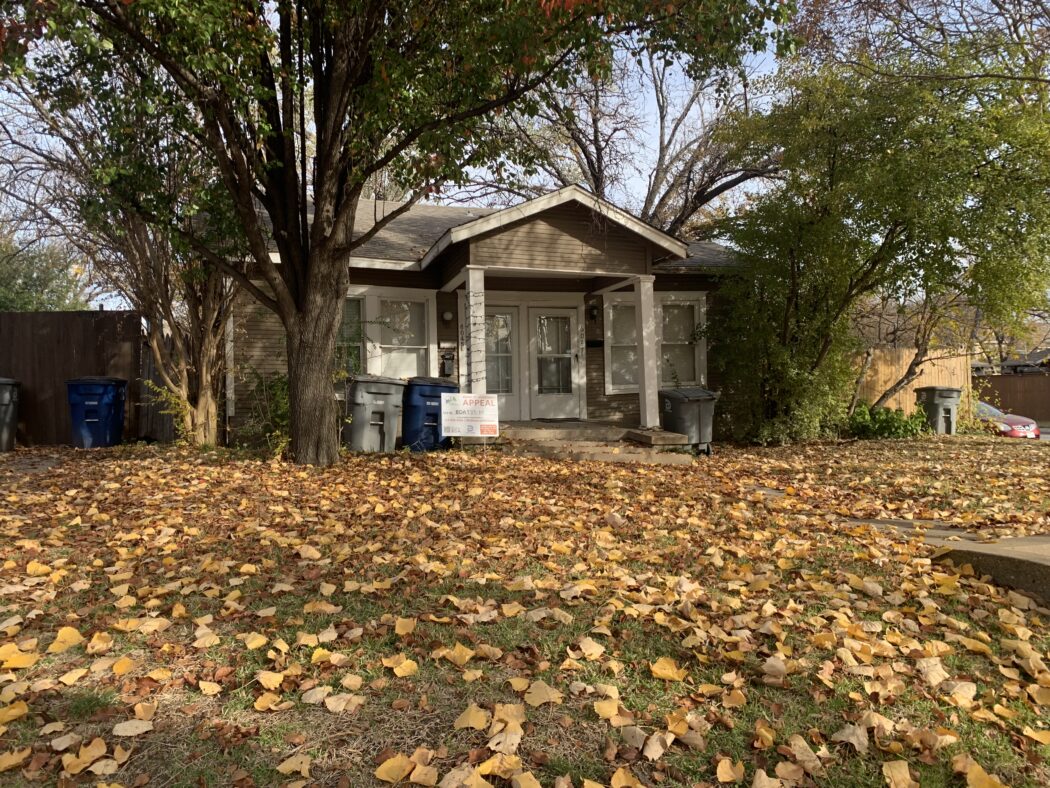
Philip and Melissa Kingston, who helped champion the original passage of Belmont Addition Conservation District (BACD), recently filed for three variances to a lot they own inside the District at 6045 Velasco.
The Kingstons hope to complete an extensive remodel of the existing duplex on the site. They sought 1) a variance to provide a 3-foot setback on the west sideyard, where the ordinance requires 5 feet; 2) a variance to provide a 3-foot-9-inch setback on the east sideyard, where the ordinance requires 10 feet; and 3) to increase the lot coverage to 50.7% — the existing ordinance limits lot coverage to 45%.
The variance applications were heard at the December 13 Board of Adjustment hearing. The Board of Adjustment is a citizen board made up of 15 appointees, one appointed by each Council Member plus a mayoral appointment. The Board is divided into three panels of five members who hear applications to the Board once a month. The five-member Panel B heard a presentation from Melissa Kingston about the request, as well as from neighbors who wanted to provide their thoughts on the request.
The Board has the power to approve any variance request, conservation district or not, provided the variance meets these three standards:
- Is not contrary to the public interest.
- Is necessary to permit the development of a specific parcel of land that differs from other parcels of land by being of such a restrictive area, shape or slope.
- Is not granted to relieve a self-created or personal hardship.
A recording of the entire 2 ½ hour meeting is posted on the City’s website here. The case for 6045 Velasco begins at the 1 hour 25 minute mark.
Kingston said the sideyard variances would allow enough width to add two two-car garages with alley access, and the lot coverage variance would allow the Kingstons to preserve more of the original structure and include other amenities in the building that families want.
She punctuated her opening remarks saying, “We would not be here asking for variances that hurt the neighborhood.”
It was a role reversal of sorts for Melissa Kingston, who is the Plan Commissioner for District 14 and every month sits on the other side of the table, hearing requests from landowners and developers hoping for rezones, special use permits, etc.
Board of Adjustment member Sarah Lamb asked Kingston what level of community outreach or communication she had with neighbors. Although the Board of Adjustment had received seven letters of opposition to the variance request from residents within the 200 feet notice area and no letters of support from within the notice area, Kingston said she spoke to about 50 neighbors who “didn’t have a problem with it”. Six letters in favor of the request were received by the Board from residents outside of the notice area. As was pointed out during the hearing by some of the neighbors offering their opinions, the Kingstons did not schedule any public meetings to discuss the requests or initiate any direct conversations with the next-door neighbor or the neighbor across the alley — the two residents closest to the property.
“Let’s just say it might be political,” Melissa said during the meeting. “None of the people who opposed it approached us either.”
A few minutes later Lamb followed up: “You (Melissa Kingston) do sit on another commission, and if you were in my shoes and your applicant mentioned they had not reached out to those in the notice zone, would you tell me to go and do a little bit more work and reach out to the community?”
“I think it probably depends,” Melissa responded. “This is a very engaged neighborhood, and people know who we are, frankly. We host a lot of community events at our home. We historically have. So I would have thought that people who are sitting in this room who know exactly who we are if they have a question or an issue would have contacted us. I frankly don’t know that I think it’s going to make that big a difference because I don’t think that opposition to this application or changes to the conservation district is what’s driving the opposition.”
Eight residents of the Belmont Conservation District spoke in opposition to the request. No one other than the Kingstons appeared at the hearing in favor of the request.
Several residents said they were pleased that improvements were planned to the current structure. They recounted the dilapidated condition of the property and the nuisance it has created for years, but they also said they believed Conservation District rules should be honored in the re-development of this property as the existing non-conforming use or the construction of a new single-family home.
The first speaker in opposition was Robert Granado, whose parents bought the home at 6043 Velasco next door to the Kingston property in 1969. Granado grew up in the existing house and now lives there.
Granado told the board he believes the Kingstons can and should remodel the duplex or build a new single-family home within the boundaries of the BACD. He said during the hearing that’s exactly what he had to do when he attempted to install new siding on his house, was notified of a violation of the BACD by the City and had to remove the new siding and install it a second time.
“I am concerned about Ms. Kingston mentioning this as being political,” Granado said during the hearing. “I was never approached from Ms. Kingston about anything about this. I didn’t know what was happening. I don’t know how my privacy is political. I don’t know how my safety is political. I’m right next door. I received no contact from Ms. Kingston.”
Jon Schulz, another speaker in opposition, began a discussion with the board about lot coverage by reminding the board that the lot coverage calculation for compliance purposes is for the first-floor footprint only. With approval of the variance request, Schulz said during the hearing, the Kingstons could build substantially more livable space. In the ensuing discussion, board members and board staff estimated that somewhere between 7,000 and 7,500 square feet of space, including garages and patios, could be built on the 8,000-square-foot lot that currently is home to a 1,300-square-foot duplex and a small accessory unit. (Editor’s note: On an 8,000-square-foot lot, such as the Kingstons’, the maximum lot coverage of 45% would be 3,600 square feet on the first-floor footprint only. However, since the Conservation District allows construction height up to 30 feet, and since the second floor must be set back from the first-floor perimeter boundary, the total livable space under all roofs for the Kingstons’ request to build 4,057 square feet on the first floor — 50.7% lot coverage — could be up to 7,000-7,500 square feet. In fact, either the Kingstons’ variance request or the existing 45% lot coverage limitation could eventually result in buildings of 6,500-7,500 square feet, based on various possible ways to develop building plans eventually submitted to and approved by the City prior to beginning construction.)
“Philip chose to purchase the property knowing full well the Conservation District requirements, as well as typical construction in the area,” Schulz said during the hearing. “This is a position he has placed himself into voluntarily with full knowledge of the challenges that faced him. He is now attempting to sidestep the very Conservation District which he helped create in order to maximize his real estate investment.”
Darren Carollo of 6038 Velasco, across the street from the Kingstons’ property, echoed others in opposition to the request, noting the Kingstons hadn’t approached him about the request; Carollo said that while he was happy about improvements being made to the existing duplex, he believed improvements should be made within the regulations of the Conservation District as written.
James Faulkner, 6046 Llano across the alley from the Kingstons’ property, also spoke in opposition, telling the board that he was concerned about the lack of plans available for the neighborhood to get a full picture of what is possible with any variance approval.
In her rebuttal time, Melissa Kingston told the board: “You will not find two people who are more ardent supporters of the Conservation District than us. I do not believe that the requests we are asking for would damage this neighborhood in the least. What we are going to be able to do if you grant these requests is to preserve the existing structure in a way that we cannot do without the variances and create a product that families want to live in.”
As the Board debated the variance requests, there was significant discussion among the members, especially Lamb and Trevor Brown, chief planner of the city’s Conservation District office, about the sequencing of plan review by Brown and his staff.
The Board of Adjustment ultimately offered half-a-loaf to each side. The vote was unanimous, 5-0, in granting each of the sideyard setback requests. The lot coverage variance was denied, 3-2, with members Cheri Gambow, Sarah Lamb and Joseph Cannon voting to deny the request, and members Michael Karnowski and Nicholas Brooks voting to approve.
The board’s decision to deny the lot coverage request was made “without prejudice”, meaning the Kingstons can re-apply for the variance at any time; if they do, another public hearing to hear their request would be scheduled.
Faulkner said after the vote that he believed the board exceeded its authority and didn’t apply the standards correctly.
“We have a Conservation District in name only,” Granado said after the meeting.
Neighbor Amanda Schulz felt that the Kingstons’ application didn’t meet the three standards the Board must consider when reviewing variance requests. Schulz said she could accept the sideyard variances to avoid a Skillman garage entrance and provide the necessary width to build the garages.
“I was very pleased to see the Board deny the variance for the expansion of the lot coverage,” Schulz said. “At the end of the day, they can build within the guidelines that they themselves helped establish without any undue burden.”
The Advocate made multiple attempts to contact Melissa Kingston for comments and also reached out to Philip Kingston regarding the Board’s decision. No response was received.
As she adjourned the meeting, board vice chairman Cheri Gambow spoke to every one in the room:
“I’m very hopeful this house will be a better situation than what you have today. I implore the Kingstons to work with the neighbors. Be kind to the neighbors. Please do a good job. Please don’t let us down. I hope ya’ll can work together,” Gambow said. “I’m going to trust that you guys will put something in that everybody will feel really good about when it’s done.”





